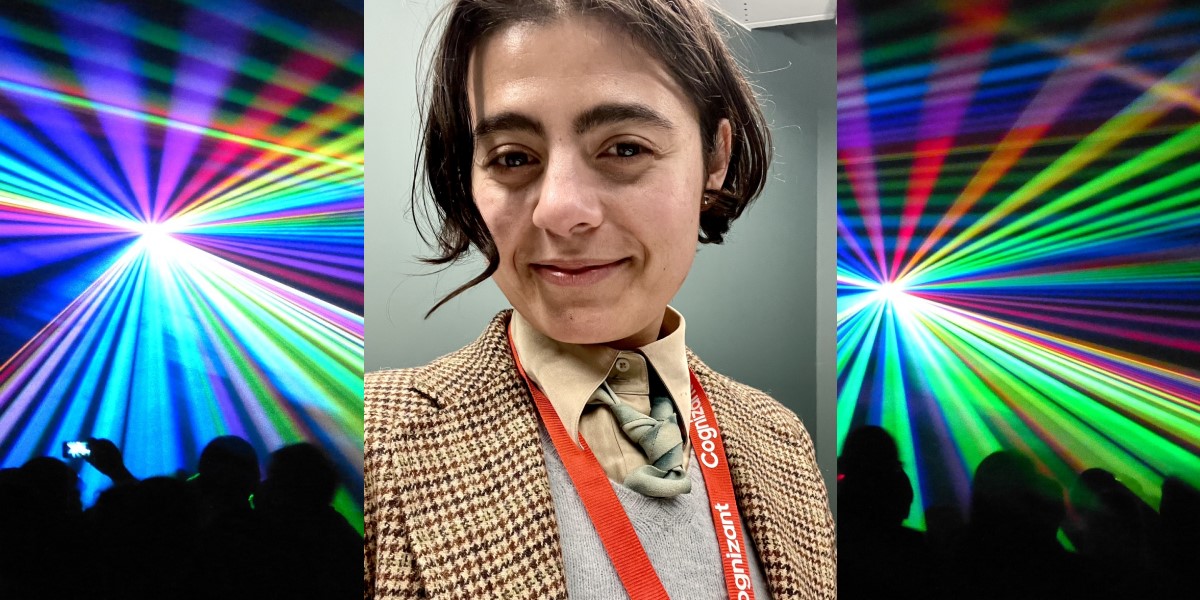A profile of PhD graduate Alina Striner

Alina Striner, UMD INFO College Alumna, PhD Program
Alina Striner’s home is a wonderland. Ivy hangs from the ceiling; on the walls are a stained glass decal she painted to look more 3D, and a simple shower curtain painted gold to give it texture. “I like to collect stuff. And I like to create worlds,” Striner says. “I’ve always considered myself an artist.” While at the UMD INFO College pursuing her PhD, she was able to explore the intersection between human-computer interaction (HCI), education, and art experiences, which included her dissertation work on multisensory VR training of outdoor habitats.
She didn’t know much about the INFO College when she applied. When she visited the human-computer interaction lab (HCIL) and saw toys, a muppet, and a makerspace, she was struck by the lab’s playfulness and knew she wanted to be part of it. She was also drawn to the interdisciplinary nature of information studies and knew there’d be room for her interests.
She studied consumer psychology before joining the INFO College and wanted to integrate some of that learning, particularly around how people consume media, into her work. Traditional media may seem passive–you enjoy a bowl of popcorn while watching a Netflix movie–but we’re always engaging, reacting, and responding to what we see. This becomes amplified when we watch a movie in the theater. Having a shared experience with others–hearing someone laugh or cry–heightens our own emotions. Some mediums are more interactive, such as theme parks, games, and plays. Striner studied how audiences participate in those mediums. Interactive performances and games allow audiences to engage with concepts and ideas deeply in ways that they might not be able to in their everyday lives.
She was able to apply her research interests to some of her coursework. In a course with Jon E. Froehlich, she spent most of class time working with her peers on a project. “Here are the project specs, make something,” was the instruction from her professor. “See if it works. If it doesn’t, then try something else.” Her team created shoes with sensors that made different sounds as the wearer walked. They could be used in theater performances as sound effects. The sounds of creaking boards could create a scary atmosphere, or the crunching of snow underfoot could signal a scene change.
“It was hands-on and collaborative. We all had different experiences, but we were working together toward a shared goal,” Striner says.
She did her post-doc work in Amsterdam at the Dutch National Research Institute for Mathematics and Computer Science. She worked in an immersive media lab developing artistic co-creation technology for opera houses in the Netherlands, Spain, Portugal, and Ireland. Her focus was on user-centric design research. As a senior user experience researcher, she does similar work now for Cognizant, a tech consulting firm. What Striner finds most exciting about her field is that “you can be passionate about anything and find someone working on it in HCI.”
Striner credits the nurturing, open community at the INFO College with helping her achieve success. In addition to the expertise she gained, she also learned how to ask better questions, ideate, and give more engaging presentations. Those skills have helped her immensely in her career. “I feel fortunate I fell into the HCIL having not known so much about it.”
Her advisor Jennifer Preece was former dean of the college and was one of the first women to have such a prominent position in the field. “I really have had mentorship and been able to see positive female roles. When you see someone that’s representative of you, you also feel that you can be successful.”